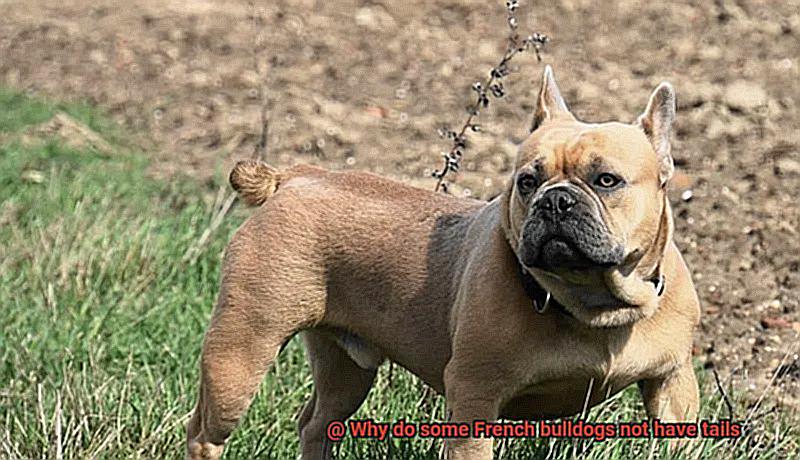Why do some French bulldogs not have tails?
French Bulldogs, those irresistible bundles of charm and personality, have stolen the hearts of dog enthusiasts across the globe. But here’s something that might have caught your eye – some of these adorable pooches are rocking a tail-less look.
It’s a fascinating quirk exclusive to this breed that leaves us pondering: why do some French Bulldogs not have tails? In this blog post, we’ll embark on an exhilarating journey through history, genetics, and selective breeding practices to uncover the secrets behind this unique trait.
Get ready to dive deep into the captivating world of French Bulldog genetics and unravel centuries-worth of tales (or lack thereof) that have shaped their distinctive appearance.
What is the Natural Bobtail Gene?
Contents
- 1 What is the Natural Bobtail Gene?
- 2 How Does the Natural Bobtail Gene Affect French Bulldogs?
- 3 Origins of the Natural Bobtail Gene in French Bulldogs
- 4 Potential Health Implications of Not Having a Tail
- 5 Tail Docking in French Bulldogs
- 6 The Controversy Surrounding Tail Docking
- 7 Finding a Responsible Breeder for French Bulldogs Without Tails
- 8 Conclusion
French Bulldogs are known for their adorable and distinctive appearance, from their bat-like ears to their compact bodies. But did you know that some French Bulldogs are born without tails or with significantly shorter tails?
This intriguing characteristic is due to the natural bobtail gene, a fascinating genetic mutation that has been passed down through generations.
In this blog post, we will delve into the world of the natural bobtail gene and explore its characteristics, inheritance patterns, and potential implications for French Bulldogs.
The Natural Bobtail Gene: A Tail-less Wonder
The natural bobtail gene is a genetic mutation that causes certain dog breeds, including French Bulldogs, to be born without a tail or with a shortened tail. These dogs are often referred to as “naturally bobbed” or “naturally tailless.” This unique trait adds an adorable charm to these dogs, setting them apart from their tailed counterparts.
Exploring Inheritance Patterns
The natural bobtail gene follows an autosomal dominant inheritance pattern. If a French Bulldog inherits this gene from either parent, it will not have a tail. However, if it receives the normal tail gene from both parents, it will have a typical tail. This means that even French Bulldogs with one copy of the natural bobtail gene will exhibit the trait.
The exact origin of the natural bobtail gene in French Bulldogs remains a mystery. However, it is believed to have originated from a spontaneous mutation within the breed’s genetic pool. Over time, this mutation became prevalent in certain bloodlines and continues to be passed down through selective breeding.
Health Implications and Considerations
It’s important to note that the natural bobtail gene does not cause any health issues or complications for French Bulldogs.
It is simply a physical characteristic that sets them apart from other dogs. However, without a tail, these dogs may have difficulties communicating through tail wagging and expressing their emotions.
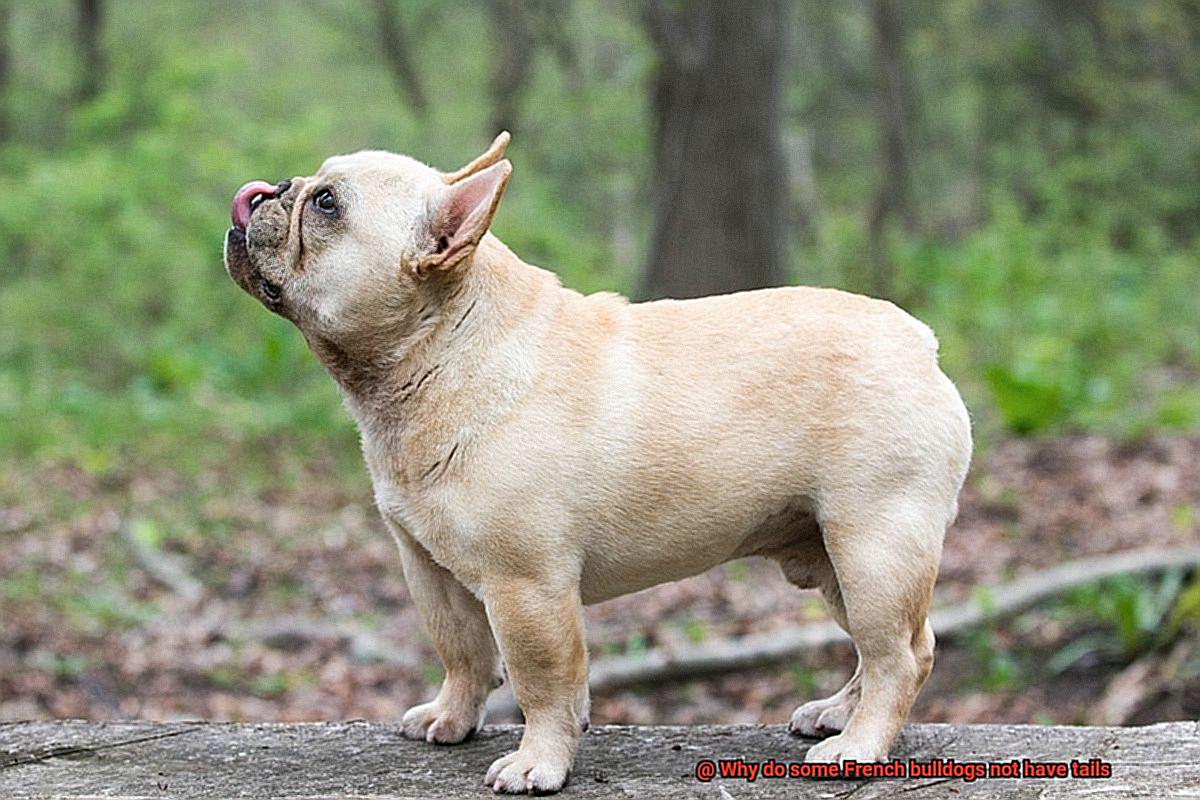
They rely more on facial expressions and body language to convey their feelings.
Additionally, the absence of a tail can affect their balance and coordination to some extent. French Bulldogs with a natural bobtail may have slightly different movement patterns compared to those with a full-length tail. However, with proper care and attention, they can lead happy and fulfilling lives.
Ethical Considerations: Responsible Breeding Practices
While some breeders intentionally select for the natural bobtail trait, others consider it a fault in the breed standard and do not intentionally breed for it. Breed standards for French Bulldogs may vary in different countries or kennel clubs regarding whether a tail is required or preferred.

If you are considering getting a French Bulldog without a tail, it is crucial to choose a reputable breeder who follows ethical breeding practices and prioritizes the health and well-being of their dogs.
How Does the Natural Bobtail Gene Affect French Bulldogs?

French Bulldogs are renowned for their adorable appearance, characterized by compact bodies, bat-like ears, and expressive eyes. However, some French Bulldogs possess a fascinating genetic variation known as the natural bobtail gene, which results in the absence or shortness of their tails.
The natural bobtail gene is caused by a specific gene called T-box transcription factor 4 (TBX4), responsible for tail development during embryonic growth. When this gene is altered or mutated, French Bulldogs can be born with no tail or a significantly shortened one.
One intriguing aspect of the natural bobtail gene is that it can occur spontaneously or be selectively bred for in certain dog breeds, including French Bulldogs. Breeders who appreciate this unique characteristic intentionally breed dogs carrying the gene to produce puppies with natural bobtails.
Fortunately, French Bulldogs with natural bobtails do not experience any health issues or discomfort. It is simply a physical variation that does not affect their overall appearance or temperament. These dogs can still communicate and express themselves through other body language cues, such as facial expressions and body postures.
For some breeders and enthusiasts, the natural bobtail trait is considered a desirable characteristic that adds to the charm of the French Bulldog breed. However, it is crucial for breeders to prioritize responsible and ethical breeding practices to maintain the overall health and well-being of French Bulldogs.

Origins of the Natural Bobtail Gene in French Bulldogs
The origins of the natural bobtail gene in French Bulldogs remain a captivating mystery, adding an air of intrigue to our already enchanting companions. While the exact source is yet to be definitively determined, several theories shed light on this endearing trait.
One hypothesis suggests that the natural bobtail gene emerged through a combination of genetic mutations and selective breeding. Over time, breeders intentionally paired French Bulldogs with shorter or no tails, fostering offspring with this adorable characteristic. This carefully curated breeding process allowed the natural bobtail gene to flourish within the breed.
Another theory proposes that the gene was introduced through crossbreeding with other breeds known for their naturally short tails. Breeds such as the Australian Shepherd or Pembroke Welsh Corgi, renowned for their tail-less elegance, might have crossed paths with French Bulldogs at some point, imparting their tail-less genes onto subsequent generations.
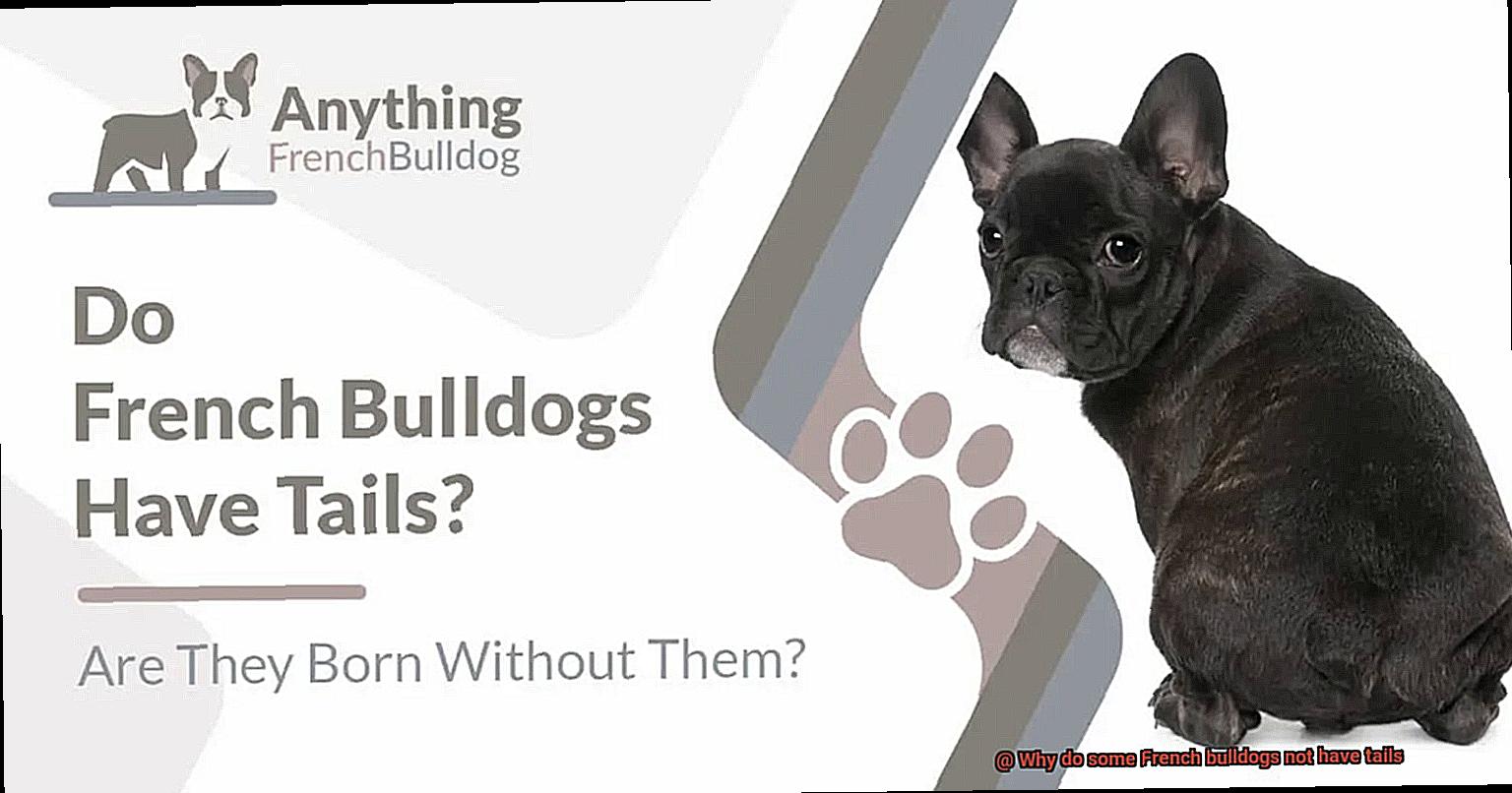
Regardless of its origins, the natural bobtail gene has become a prevalent feature in French Bulldogs today. Recognized as a distinctive attribute of the breed, it adds an extra touch of charm to these already irresistible canines.
For breeders seeking to produce French Bulldogs with natural bobtails, responsible practices are of utmost importance. Careful selection of breeding pairs and genetic testing to identify potential health issues associated with the gene mutation are crucial. Only dogs in optimal health should be used for breeding to ensure the well-being of these delightful companions.
Potential Health Implications of Not Having a Tail
Among their many charming features, the absence of a tail sets French Bulldogs apart. While this endearing quirk may seem inconsequential, it is important to understand the potential health implications that come with not having a tail. So, let’s explore these implications in detail.
Skeletal Development:
The absence of a tail in French Bulldogs is primarily attributed to a genetic mutation known as the “screw tail gene.” This mutation alters the development of tail vertebrae during embryonic growth, resulting in either a shortened or absent tail. Although this mutation does not cause harm or discomfort to our four-legged friends, its impact on skeletal development is worth considering.
Balance Challenges:
Tails play a pivotal role in maintaining balance and stability for dogs. They act as counterbalances during movement, enabling dogs to navigate uneven terrain and preserve their equilibrium. Without a tail, French Bulldogs may be more prone to losing their balance and experiencing falls or injuries. Vigilance and extra precautions must be taken to ensure the safety of these adorable canines.
Communication Difficulties:
Tails serve as vital means of communication for dogs, allowing them to express emotions and intentions. The absence of a tail in French Bulldogs may hinder their ability to effectively convey these signals, potentially leading to misunderstandings and conflicts with other dogs or even their human companions. Understanding alternative methods of communication, such as facial expressions and body posture, can help bridge this communication gap.
Temperature Regulation Concerns:
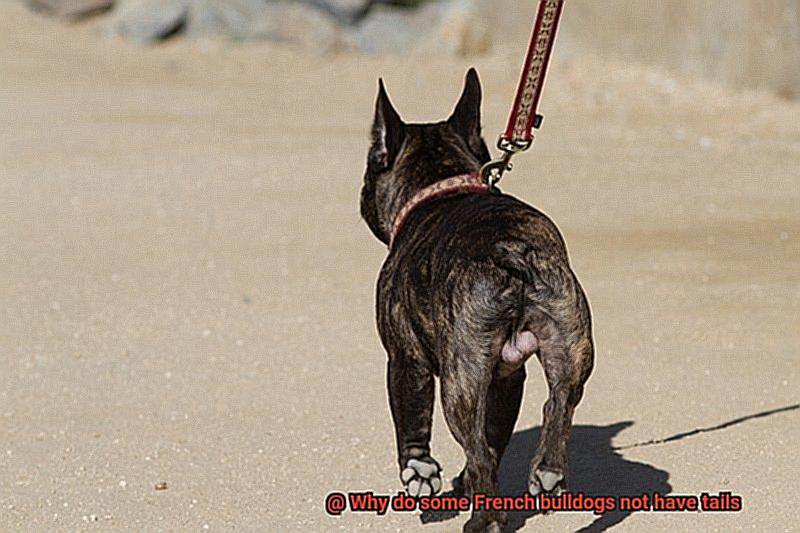
Tails also contribute to temperature regulation in dogs. They dissipate heat through wagging or holding them in specific positions, aiding in maintaining body temperature. In hot weather, dogs often elevate their tails to enhance airflow around their bodies.
Without a tail, French Bulldogs may have reduced ability to efficiently regulate body temperature, rendering them more susceptible to heat-related illnesses like heatstroke. Providing ample shade, fresh water, and limiting exposure to excessive heat becomes essential.
In summary, the absence of a tail in French Bulldogs stems from a genetic mutation that does not cause harm but can have potential health implications related to skeletal development, balance, communication, and temperature regulation.
However, with proper care and attention, French Bulldogs can adapt and thrive, compensating for the absence of a tail through alternative means of communication. Embracing and understanding these unique characteristics will ensure that our cherished Frenchies lead happy and healthy lives.
Tail Docking in French Bulldogs
While tail docking is a common practice in certain dog breeds, it is not a natural occurrence in French Bulldogs.
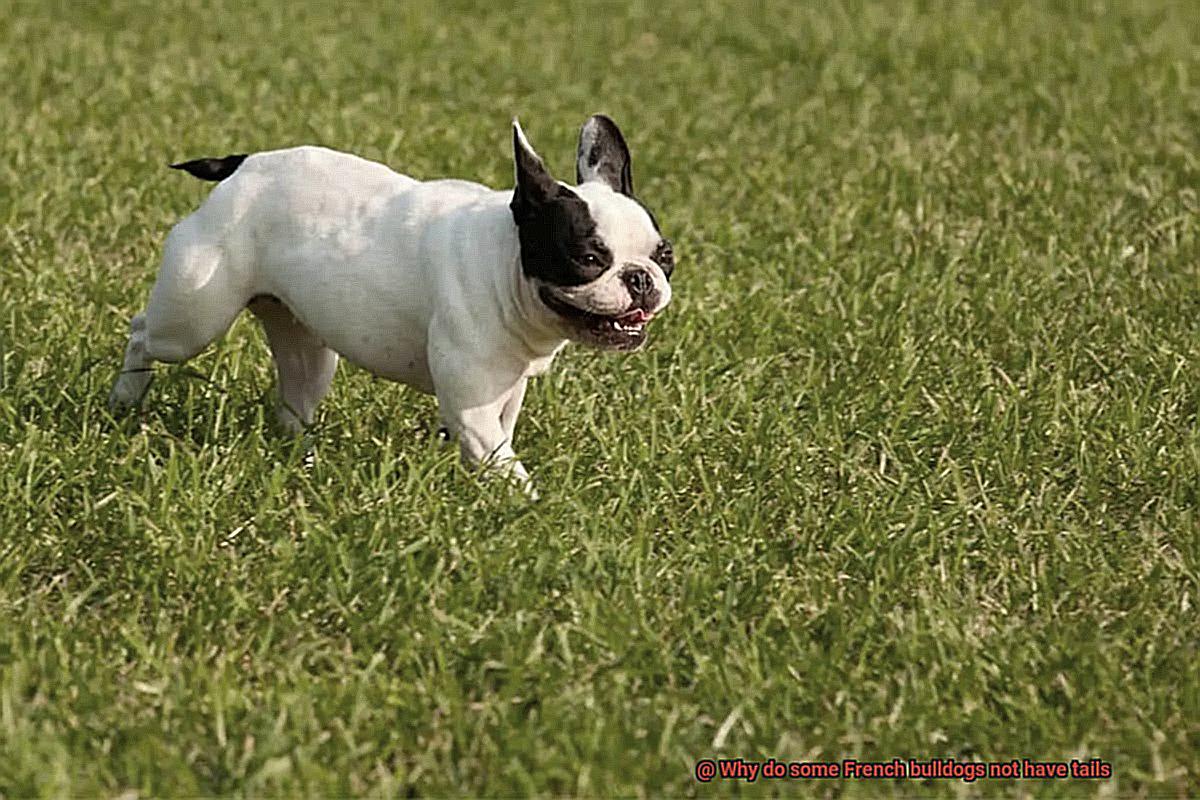
The absence of tails in some French Bulldogs is due to a genetic mutation known as “screw tail.” This mutation causes the tail to be either extremely short or curled up against the body. Unfortunately, screw tail can lead to various health issues if left untreated. In some cases, veterinarians may recommend tail docking as a preventive measure to avoid potential problems.
The decision to dock a French Bulldog’s tail is not without controversy. Many animal welfare organizations argue that tail docking for cosmetic purposes, such as conforming to breed standards or achieving a specific appearance, is unnecessary and can cause unnecessary pain and complications. Consequently, several countries have banned or restricted the practice.
If you are a responsible French Bulldog owner, it is crucial to conduct thorough research and consult with a knowledgeable veterinarian who understands the breed. They can provide valuable insight and guidance on whether tail docking is necessary for your Frenchie.
Tail docking itself involves the surgical removal of part of the puppy’s tail. The procedure is usually performed early in the puppy’s life under anesthesia to minimize pain and ensure proper healing. Afterward, the wound is sutured or cauterized to promote healing and prevent infection.
It is important to note that opponents of tail docking argue that it serves no functional purpose and should only be done if there is a legitimate medical reason. Ultimately, the decision should prioritize the well-being of your furry companion. If there are valid medical reasons for tail docking, it may be beneficial. However, if it is purely for cosmetic purposes, it may be best to let your French Bulldog keep their tail intact.
The Controversy Surrounding Tail Docking
Tail docking, the practice of removing a dog’s tail, has long been a controversial issue in the dog breeding and veterinary community. It has sparked heated debates and passionate arguments from both sides, each presenting valid points regarding its necessity and ethical implications. To truly understand the controversy surrounding tail docking, we must delve into its history, current usage, and the ethical considerations associated with it.
The history of tail docking dates back centuries, with its origins rooted in practicality rather than aesthetics. Initially, dogs were bred for specific working purposes, such as hunting or herding, and tail docking was believed to prevent injuries during these tasks. Over time, however, the perception of tail docking shifted, with some breeders and owners embracing it as a cosmetic procedure to conform to breed standards and enhance the dog’s appearance.
In the present day, tail docking remains a contentious issue. Supporters argue that it is necessary for certain breeds, such as French Bulldogs, to prevent tail injuries and maintain their unique look. They claim that docking reduces the risk of accidents and discomfort associated with a long tail. However, opponents vehemently oppose this viewpoint, considering tail docking as an unnecessary and cruel practice. They argue that it causes pain to the dog and can lead to long-term physical and psychological issues.
The ethical implications surrounding tail docking are at the heart of the controversy. Many countries have recognized these concerns and have banned or restricted tail docking as an act of animal cruelty. These countries include several European nations that prioritize animal welfare and advocate against unnecessary surgical procedures. However, in some regions, tail docking is still legal and even a common practice for certain breeds like Doberman Pinschers and Boxers.
To address the concerns of breeders and owners without resorting to surgery, alternatives to tail docking have been proposed. Selective breeding for shorter tails is one such option that aims to reduce the risk of injuries without altering the dog’s natural anatomy. Additionally, proper training and socialization can play a crucial role in preventing accidents and injuries, ensuring the well-being of the dog.
In conclusion, the controversy surrounding tail docking revolves around conflicting opinions on responsible dog breeding and ownership, as well as ethical considerations regarding the well-being of animals. It is essential for breeders and owners to conduct thorough research, consult knowledgeable veterinarians, and make informed decisions that prioritize the health and happiness of their dogs. By finding a balance between these factors, we can foster a more compassionate and responsible approach to tail docking and dog welfare as a whole.
Finding a Responsible Breeder for French Bulldogs Without Tails
It’s crucial to find a responsible breeder who prioritizes the health and well-being of their dogs. In this article, we will explore why finding a responsible breeder is essential and provide you with essential tips to make an informed decision.
Responsible Breeding Practices:
Responsible breeders go above and beyond to ensure their dogs are healthy and genetically sound. They prioritize breeding for desirable traits while minimizing the risk of inherited health issues. When searching for a breeder, inquire about their breeding practices and philosophy.
Thorough Health Testing:
Reputable breeders conduct extensive health testing on their breeding dogs. This guarantees that they are free from genetic disorders that could be passed on to their offspring. Look for breeders who test for conditions such as hip dysplasia, eye diseases, and spinal abnormalities that may affect the tailless trait.
Adherence to Breed Standards:
French Bulldogs have specific breed standards set by kennel clubs and breed organizations. Responsible breeders will adhere to these standards and produce puppies that meet them. Ensure that the absence of a tail in the puppies is not due to a genetic defect or injury.
Evaluating Breeder Reputation:
Research and evaluate the reputation of potential breeders before making a decision. Read reviews, talk to previous buyers, and visit the breeder’s facility if possible. This will give you insights into their breeding practices, the health of their dogs, and how they care for their puppies.
Ethical Considerations:
Responsible breeders prioritize the well-being of their dogs over profit. They provide a clean and safe environment for their dogs and puppies, offer proper socialization and care, and are available for support and guidance throughout the dog’s life. Avoid breeders who are solely focused on making a quick buck.
Seek Referrals and Recommendations:
Seek referrals or recommendations from local French Bulldog clubs, veterinarians, or trusted friends who have purchased from reputable breeders. These sources can provide valuable insights and guidance in locating a breeder who specializes in French Bulldogs without tails.
Em5WE9QFfa0″ >
Conclusion
In conclusion, the absence of tails in some French Bulldogs is not just a quirky trait, but a result of the captivating natural bobtail gene. This genetic mutation adds an irresistible charm to these dogs, setting them apart from their tailed counterparts. Interestingly, the natural bobtail gene follows an autosomal dominant inheritance pattern, meaning that even French Bulldogs with just one copy of the gene will exhibit this unique characteristic.
The exact origins of the natural bobtail gene in French Bulldogs remain shrouded in mystery, but it is believed to have emerged from a spontaneous mutation within the breed’s genetic pool. Over time, this mutation became prevalent in certain bloodlines and continues to be passed down through selective breeding.
It’s important to note that having a natural bobtail does not pose any health issues or complications for French Bulldogs. However, without a tail, these dogs may face challenges when it comes to communicating through traditional tail wagging and expressing their emotions. Instead, they rely heavily on their expressive faces and body language to convey their feelings. Furthermore, the absence of a tail can slightly affect their balance and coordination.
When considering adding a tail-less French Bulldog to your family, it is crucial to choose a reputable breeder who upholds ethical breeding practices and prioritizes the health and well-being of their dogs. Responsible breeders conduct thorough health testing, adhere strictly to breed standards, and provide clean and safe environments for their dogs and puppies.
